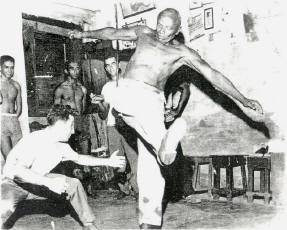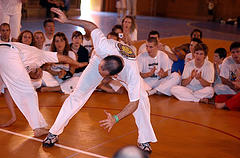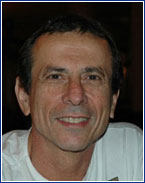Dance Styles
"Ai, ai, Aidê, joga bonito que eu quero ver... / Joga bonito que eu quero aprender."
Ai, ai, Aidê, play pretty 'cause I want to see... / Play pretty 'cause I want to learn.
When capoeira was originally brought to Brazil by African slaves, it was done as a war-like dance. Early capoeira eventually evolved through time and influence of other forms of fight and dance from Africa. Capoeira then was a restricted exercise in Bahia. Bahian capoeiristas practiced capoeira as a ritual-dance-fight-game. When brought to Rio de Janeiro, capoeira developed into a form of fighting. By the time it reached both Rio and Sao Paulo around the 1960s, the dance style added Asian martial arts to its techniques, giving it a more organized image to attract students.
The capoeirista always plays the dual role of teacher and student. He learns as well as teaches in the roda, or the circle in which capoeira is performed, and in life.
Two widely known central figures in the history of capoeira are Mestre Bimba and Mestre Pastinha. The creators of styles later named Capoeira Regional and Capoeira Angola, these mestres, or capoeira masters, are often the central ancestors of capoeira players.
L to R: Mestre Bimba, Mestre Pastinha
Capoeira Regional was created around the 1990s by Manoel dos Reis Machado, better known as Mestre Bimba. During this time, capoeira was taught simply to promote the Brazilian sport. Capoeira Regional was what Mestre Bimba called "the regional fight from Bahia." This style uses less of the slow, rhythmical "ritual and game" characteristic. Bimba instead preferred a more quick-paced, aggressive fighting style, altering most of the existing kicks in traditional capoeira. Intense warm ups and systematic blows are practiced. His academy included students of different social classes as opposed to the traditional Afro-Brazilian students of an underprivileged class. The Regional style is very much structured, allowing for techniques to develop more quickly in early stages of practice. The downfall of this ordered style is that it may prevent students from exploring their own individuality in capoeira dance.
Mestre Bimba and the Regional style
Later performed by Vicente Ferreira Pastinha, or Mestre Pastinha, Capoeira Angola was the name given to the traditional capoeira style. A more spontaneous dance, Capoeira Angola involves more flexibility and improvisation. Games place great emphasis on body language, performing artistic and visual qualities. As opposed to Regional, this style is performed to a slower rhythm, at times extending the length of games, with movements that keep the body close to the ground. Today, however, Angola instructors are teaching similarly to the Regional/Senzala style, using repeating methods, and predetermined sequences of blows and movements like that of Bimba's sequences. (see Capoeira Angola)
Mestre Pastinha and the Angola style
Capoeira students originally from Rio de Janeiro went to Salvador to study with Mestre Bimba. Upon their return to Rio, they began the Senzala group, built on Mestre Bimba's methods. The Senzala group is the most famous in Brazil. They practice and teach a Regional/Senzala style that resembles the newly created capoeira championships with judges and rules. Gymnastic exercises and stretching techniques are taught in addition to Bimba's systematic blows and movements. Similar to Eastern martial arts, Regional/Senzala movements are done while simultaneously following the instructor's lead. Mestre Bimba's Regional style is rarely seen today, Regional/Senzala has taken its place while still drawing on and modifying Bimba's existing kicks and movements.
L to R: Regional/Senzala style; Mestre Gato of the Senzala group
Home | History | Music | Capoeira Today | Bibliography | Perf62 | Basic Terms
.jpg)



